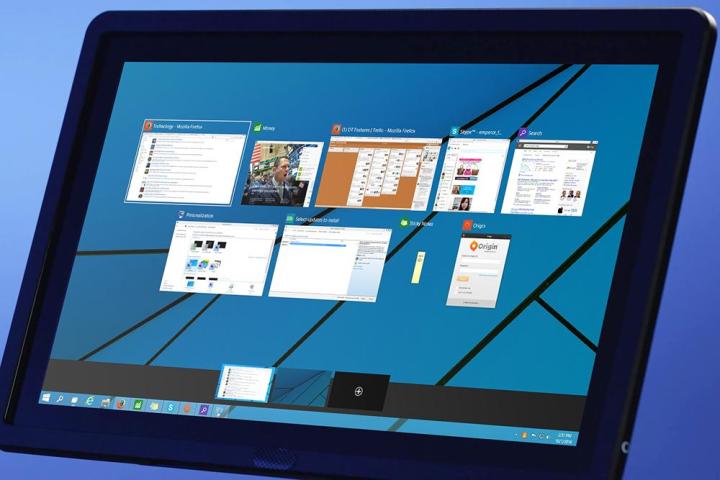
While there’s no new feature in the second update’s change-log that’s quite as compelling as the Action Center (which made its debut in 9860), beta testers are getting plenty to play with here. First and foremost, some new Mac OS X-like gestures will be available to use.
Previewed by MS Operating Systems Group VP Joe Belfiore, these allow you to easily enter Task View with a three-finger upward movement. Three finger downward swipe brings up the Desktop. Three-finger side flicks seamlessly switch between apps.
A three-finger move to the left or right is the equivalent of pressing Alt-Tab. This also puts the spotlight on Task View, allowing you to select an app by simply removing your fingers from the touch-pad. Hopefully, Microsoft’s new gestures are as fluid as they are on OS X.
Win 10 tech preview users should be happy to hear that Redmond made a series of changes based on their feedback. The Search and Task View buttons can be easily hidden now via a right-click menu, and a boatload of crash and hang glitches were allegedly fixed as well.
Also, app minimize and restore animations should be less “jarring.” A “hamburger-style” icon replaces the 3-dot button in Metro apps, which stores functions like Charms and full-screen mode.
Some uber-subtle Internet Explorer UI refinements you may not even notice are all ready for prime-time as well. More importantly, native MKV support, which was introduced with Build 9860, makes more sense in version 9879. Now, you can play MKV files straight from Windows Media Player, and the File Explorer shows native thumbnails and metadata for the popular multimedia format.
Last but certainly not least, Microsoft continues to aggressively push OneDrive to Windows users, enabling selective synchronization. What that means is any and all confusion surrounding what’s stored in the cloud and available online-only should now be gone.
Unfortunately, this is the last update planned for 2014. Yes, the holidays are nigh, but it’s disappointing to hear that we’ll be waiting at least two months for the next update.
Also, Microsoft has only pledged to fix two of the five errors identified in Build 9860 before rolling out the next major Technical Preview build. Namely, black screen errors at log-in or unlock, and Distributed File System network connection bugs will be repaired.
Meanwhile, there’s no fix on the way for disk space anomalies. Skype calls will disconnect and the Music app will stop playing if you minimize either of those apps, and unspecified Lync screen sharing “issues” will persist.
Want to give Build 9879 a try? In Windows 10, go to “PC Settings,” “Update and recovery,” and “Preview builds.” Then, click “Check Now,” and give the installation your blessing there.
Editors' Recommendations
- Microsoft announces a new threat to push people to Windows 11
- How to get Windows 11 for free
- This new Windows 11 feature is a great addition for PC gamers
- Microsoft Build 2022: What to expect for Teams, Edge, and Windows
- Here’s a fix for the new Windows 11 preview update issue


